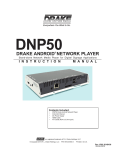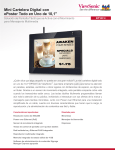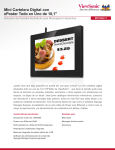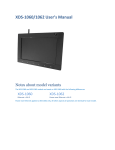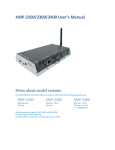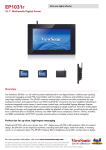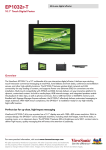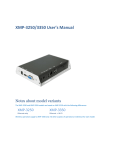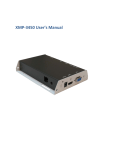Download ViewSonic EP1032r-T User guide
Transcript
EP1031r/EP1032r-T Multimedia Digital Poster User Guide IMPORTANT: Please read this User Guide to obtain important information on installing and using your product in a safe manner, as well as registering your product for future service. Warranty information contained in this User Guide will describe your limited coverage from ViewSonic Corporation, which is also found on our web site at http:// www.viewsonic.com in English, or in specific languages using the Regional selection box in the upper right corner of our website. “Antes de operar su equipo lea cu idadosamente las instrucciones en este manual” Model No. VS15683 Compliance Information NOTE: This section addresses all connected requirements and statements regarding regulations. Confirmed corresponding applications shall refer to nameplate labels and relevant markings on unit. FCC Statement This device complies with Part 15 of the FCC Rules. Operation is subject to the following two conditions: (1) this device may not cause harmful interference, and (2) this device must accept any interference received, including interference that may cause undesired operation. NOTE: This equipment has been tested and found to comply with the limits for a Class A/Class B digital device, pursuant to Part 15 of the FCC Rules. These limits are designed to provide reasonable protection against harmful interference when the equipment is operated in a commercial environment. This equipment generates, uses, and can radiate radio frequency energy and, if not installed and used in accordance with the instructions, may cause harmful interference to radio communications. Operation of this equipment in a residential area is likely to cause harmful interference in which case the user will be required to correct the interference at his/her own expense. • Reorient or relocate the receiving antenna. • Increase the separation between the equipment and receiver. • Connect the equipment into an outlet on a circuit different from that to which the receiver is connected. • Consult the dealer or an experienced radio/TV technician for help. Warning: To comply with the limits for the Class A/Class B digital device, pursuant to Part 15 of the FCC Rules, this device must be installed in computer equipment certified to comply with the Class A/Class B limits. All cables used to connect the computer and peripherals must be shielded and grounded. Operation with noncertified computers or non-shielded cables may result in interference to radio or television reception. Changes and modifications not expressly approved by the manufacturer could void the user’s authority to operate this equipment. RF exposure warning statement This equipment must be installed and operated in accordance with provided instructions and the antenna(s) used for this transmitter must be installed to provide a separation distance of at least 20 cm from all persons and must not be co-located or operating in conjunction with any other antenna or transmitter. End-users and installers must be provide with antenna installation instructions and transmitter operating conditions for satisfying RF exposure compliance. i The equipment complies with FCC RF exposure limits set forth for an uncontrolled environment. The equipment must not be co-located or operating in conjunction with any other antenna or transmitter. This equipment must be installed and operated in accordance with provided instructions and must not be co-located or operating in conjunction with any other antenna or transmitter. End-users and installers must be provide with antenna installation instructions and transmitter operating conditions for satisfying RF exposure compliance. For Canada CAN ICES-3 (A/B)/NMB-3(A/B) CE Conformity for European Countries The device complies with the EMC Directive 2004/108/EC and Low Voltage Directive 2006/95/EC. Following information is only for EU-member states: The mark shown to the right is in compliance with the Waste Electrical and Electronic Equipment Directive 2002/96/EC (WEEE). The mark indicates the requirement NOT to dispose of the equipment as unsorted municipal waste, but use the return and collection systems according to local law. If the batteries, accumulators and button cells included with this equipment, display the chemical symbol Hg, Cd, or Pb, then it means that the battery has a heavy metal content of more than 0.0005% Mercury or more than, 0.002% Cadmium, or more than 0.004% Lead. Industry Canada Notice This device complies with Canadian RSS-210.To prevent radio interference to the licensed service, this device is intended to be operated indoors and away from windows to provide maximum shielding. Equipment (or its transmitting antenna) that is installed outdoors is subject to licensing. The installer of this radio equipment must ensure that the antenna is located or pointed such that it does not emit RF field in excess of Health Canada limits for the general population; consult Safety Code 6, obtainable from Health Canada’s website www.hc-sc.gc.ca/rpb. ii R&TTE Compliance Statement This device complies with the Essential Requirements of the R&TTE Directive of the European Union (1999/5/EC). This equipment meets the following conformance standards: ETSI EN 300 328 EN 301 489-01 EN 301 489-17 EN 62311 Notified Countries: Germany, UK, Netherlands, Belgium, Sweden, Denmark, Finland, France, Italy, Spain, Austria, Ireland, Portugal, Greece, Luxembourg, Estonia, Latvia, Lithuania, Czech Republic, Slovakia, Slovenia, Hungary, Poland and Malta. iii Declaration of RoHS2 Compliance This product has been designed and manufactured in compliance with Directive 2011/65/EU of the European Parliament and the Council on restriction of the use of certain hazardous substances in electrical and electronic equipment (RoHS2 Directive) and is deemed to comply with the maximum concentration values issued by the European Technical Adaptation Committee (TAC) as shown below: Substance Proposed Maximum Concentration Actual Concentration Lead (Pb) 0,1% < 0,1% Mercury (Hg) 0,1% < 0,1% Cadmium (Cd) 0,01% < 0,01% Hexavalent Chromium (Cr6+) 0,1% < 0,1% Polybrominated biphenyls (PBB) 0,1% < 0,1% Polybrominated diphenyl ethers 0,1% (PBDE) < 0,1% Certain components of products as stated above are exempted under the Annex III of the RoHS2 Directives as noted below: Examples of exempted components are: 1.Mercury in cold cathode fluorescent lamps and external electrode fluorescent lamps (CCFL and EEFL) for special purposes not exceeding (per lamp): (1) Short length (≦500 mm): maximum 3.5 mg per lamp. (2) Medium length (>500 mm and ≦1,500 mm): maximum 5 mg per lamp. (3) Long length (>1,500 mm): maximum 13 mg per lamp. 2.Lead in glass of cathode ray tubes. 3.Lead in glass of fluorescent tubes not exceeding 0.2% by weight. 4.Lead as an alloying element in aluminium containing up to 0.4% lead by weight. 5.Copper alloy containing up to 4% lead by weight. 6.Lead in high melting temperature type solders (i.e. lead-based alloys containing 85% by weight or more lead). 7.Electrical and electronic components containing lead in a glass or ceramic other than dielectric ceramic in capacitors, e.g. piezoelectronic devices, or in a glass or ceramic matrix compound. iv Safety Precautions FOR OPTIMUM PERFORMANCE, PLEASE NOTE THE FOLLOWING WHEN SETTING UP AND USING THE LCD COLOR MONITOR: • DO NOT REMOVE MONITOR BACK COVER. There are no user serviceable parts inside and opening or removing covers may expose you to dangerous shock hazards or other risks. Refer all servicing to qualified service personnel. • Do not spill any liquids into the cabinet or use your monitor near water. • Do not insert objects of any kind into the cabinet slots, as they may touch dangerous voltage points, which can be harmful or fatal or may cause electric shock, fire or equipment failure. • Do not place any heavy objects on the power cord. Damage to the cord may cause shock or fire. • Do not place this product on a sloping or unstable cart, stand or table, as the monitor may fall, causing serious damage to the monitor. • Do not place any objects onto the monitor and do not use the monitor outdoors. • The inside of the fluorescent tube located within the LCD monitor contains mercury. Please follow the laws or rules of your municipality to dispose of the tube properly. • Do not bend power cord. • Do not use monitor in high temperature, humid, dusty, or oily areas. • If monitor or glass is broken, do not come in contact with the liquid crystal and handle with care. • Allow adequate ventilation around the monitor, so that heat can properly dissipate. Do not block ventilated openings or place the monitor near a radiator or other heat sources. Do not put anything on top of the monitor. • The power cable connector is the primary means of detaching the system from the power supply. The monitor should be installed close to a power outlet, which is easily accessible. • Handle with care when transporting. Save packaging for transporting. • Please clean the holes of back cabinet to reject dirt and dust at least once a year because of set reliability. • If using the cooling fan continuously, it’s recommended to wipe holes a minimum of once a month. • When installing the remote control batteries; - Align the batteries according to the (+) and (-) indications inside the case. - Align the (-) indication of the battery first inside the case. v CAUTION: Immediately unplug your monitor from the wall outlet and refer servicing to qualified service personnel under the following conditions: • When the power supply cord or plug is damaged. • If liquid has been spilled, or objects have fallen into the monitor. • If the monitor has been exposed to rain or water. • If the monitor has been dropped or the cabinet damaged. • If the monitor does not operate normally by following operating instructions. Recommended Use CAUTION: • For optimum performance, allow 20 minutes for warm-up. • Rest your eyes periodically by focusing on an object at least 5 feet away. Blink often. • Position the monitor at a 90° angle to windows and other light sources to minimize glare and reflections. • Clean the LCD monitor surface with a lint-free, nonabrasive cloth. Avoid using any cleaning solution or glass cleaner! • Adjust the monitor’s brightness, contrast and sharpness controls to enhance readability. • Avoid displaying fixed patterns on the monitor for long periods of time to avoid image persistence (after image effects). • Get regular eye checkups. Ergonomics To realize the maximum ergonomic benefits, we recommend the following: • Use the preset Size and Position controls with standard signals. • Use the preset Color Setting. • Use non-interlaced signals. • Do not use primary color blue on a dark background, as it is difficult to see and may produce eye fatigue due to insufficient contrast. vi Contents Compliance Information FCC Statement..................................................................................... i For Canada..........................................................................................ii CE Conformity for European Countries................................................ii Industry Canada Notice........................................................................ii R&TTE Compliance Statement...........................................................iii Declaration of RoHS2 Compliance......................................................iv Safety Precautions.............................................................................. v Recommended Use.............................................................................vi Ergonomics.........................................................................................vi Copyright Information Product Registration............................................................................ 2 For Your Records................................................................................ 2 1. Introduction 1.1 Features........................................................................................ 3 1.2 Package contents.......................................................................... 3 1.3 Physical view and features............................................................ 4 1.4 Installation..................................................................................... 5 2. C onfiguring the EP1031r/EP1032r-T 2.1 System connections...................................................................... 6 2.2 Basic settings................................................................................ 7 2.3 Connecting the EP1031r/EP1032r-T to your network................... 7 2.4 Time zone settings...................................................................... 10 2.5 Content settings.......................................................................... 11 2.6 Player information....................................................................... 12 2.7 Content configuration – AppStart................................................ 13 2.8 Content configuration – FailSafe................................................. 14 2.9 Content configuration – EasyPlay............................................... 15 2.10 Display settings......................................................................... 17 2.11 Sound settings........................................................................... 21 2.12 System configuration – Time Server......................................... 22 vii 2.13 System configuration – Scheduled reboot................................. 23 2.14 System configuration - Firmware upgrades............................... 24 2.15 System configuration - Factory reset......................................... 25 2.16 System configuration – Power save.......................................... 26 2.17 System configuration – Expand Storage by using SD card ...... 26 3. Content Management 4. Authoring in HTML5 5. Working with SMIL 5.1 Input Source................................................................................ 27 5.2 www.a-smil.org for developers.................................................... 27 6. Technical Data 6.1 Specifications.............................................................................. 28 7. Troubleshooting Other Information Customer Support............................................................................. 32 Limited Warranty............................................................................... 33 viii Copyright Information Copyright © ViewSonic® Corporation, 2013. All rights reserved. ViewSonic©, the three birds logo, OnView, ViewMatch, and ViewMeter are registered trademarks of ViewSonic Corporation. ENERGY STAR® is a registered trademark of the U.S. Environmental Protection Agency (EPA). As an ENERGY STAR® partner, ViewSonic Corporation has determined that this product meetsthe ENERGY STAR® guidelines for energy efficiency. Disclaimer: ViewSonic Corporation shall not be liable for technical or editorial errors or omissions contained herein; nor for incidental or consequential damages resulting from furnishing this material, or the performance or use of this product. In the interest of continuing product improvement, ViewSonic Corporation reserves the right to change product specifications without notice. Information in this document may change without notice. No part of this document may be copied, reproduced, or transmitted by any means, for any purpose without prior written permission from ViewSonic Corporation. 1 Product Registration To meet your future needs, and to receive any additional product information as it becomes available, please register your product on the Internet at: www.viewsonic.com. The ViewSonic® Wizard CD-ROM also provides an opportunity for you to print the registration form, which you may mail or fax to ViewSonic. For Your Records Product Name: Model Number: Document Number: Serial Number: Purchase Date: EP1031r/EP1032r-T ViewSonic Multimedia Digital Poster VS15683 EP1031r/EP1032r-T_UG_ENG Rev. 1A 09-24-13 _______________________________________ _______________________________________ Product disposal at end of product life ViewSonic respects the environment and is committed to working and living green. Thank you for being part of Smarter, Greener Computing. Please visit ViewSonic website to learn more. USA & Canada: http://www.viewsonic.com/company/green/recycle-program/ Europe: http://www.viewsoniceurope.com/uk/support/recycling-information/ Taiwan: http://recycle.epa.gov.tw/recycle/index2.aspx 2 1. Introduction 1.1 Features EP1031r • 10.1-inch widescreen LCD display and stereo speakers • 4GB on-board flash local storage with SD card slot • Built-in motion sensors and 6 touch buttons • Built-in wireless b/g/n network and Ethernet • Power over Ethernet • Supports full POPAI Screen Media Formats Standards profiles S1 to S12, and E1 to E8 • Multiple 3rd party software solution compatibility • Industry leading W3C SMIL support for developers EP1032r-T • 10-inch multi-touch widescreen LCD display and stereo speakers • 4GB on-board flash local storage with SD card slot • Built-in wireless b/g/n network and Ethernet • Power over Ethernet • Supports full POPAI Screen Media Formats Standards profiles S1 to S12, and • E1 to E8 • Multiple 3rd party software solution compatibility • Industry leading W3C SMIL support for developers 1.2 Package contents Main Unit AC Adapter Ethernet Cable Standard 3.5mm to RCA AV Adapter Display stand and screws Quick Start Guide Documentation CD Software Setup Guide Note: A USB mouse is required for system setup. 3 1.3 Physical view and features EP1031r Motion Sensor Wireless antenna post VESA mount (MIS-D 75) Touch buttons Audio out jack Ethernet Cover Kensington lock DC IN ADB HDMI Reset SD card slot USB x2 EP1032r-T Wireless antenna post VESA mount (MIS-D 75) Cover Audio out jack Ethernet Kensington lock DC IN ADB HDMI Reset SD card slot USB x2 4 1.4 Installation Fix the display stand 1. Put the supplied display stand onto the screw socket. 2. Insert the two supplied screws. 3. Fasten the screws. Fix the Kensington lock 1. Press the Kensington lock’s button and insert it into the lock slot. 2. Plug the lock into the lock hole, and then release the button. Open the back cover 1. Remove the screw from the back cover. 2. To release the back cover, slide the cover in the direction shown here, and then pull up. 5 2. Configuring the EP1031r/EP1032r-T 2.1 System connections 1. Attach the AC power adapter to provide power to the unit. After approximately 35 seconds, booting animation will be displayed on the screen below as shown here: 2. The player boot process takes approximately 60 seconds to complete. After boot up is complete, the signboard will stay in the Basic settings menu if no content service has been configured (i.e. first boot up for a brand new unit or after a factory reset). Plug in a USB mouse to start configuring the signboard. If you have already set content into the signboard, contents will start playing back automatically 15 seconds after boot up. Note: To enter the menu system at any time during playback, plug in a USB mouse and hold the left mouse key in the corner area as shown below for 10 seconds. * You will be asked for a password if a password has been pre-configured. 6 2.2 Basic settings You must attach a USB mouse to the signboard to configure settings. (Fig. 2.2.1) Basic settings allow users to configure 3 important signage application settings: Network, Time zone and Content. Each time the Basic settings menu is entered, the signboard will start playback automatically after 15 seconds if content services have been set previously. Auto playback can be canceled by clicking on the button while it’s counting down. To enter the Advanced Setting menu, click the Advanced button. 2.3 Connecting the EP1031r/EP1032r-T to your network Wireless connection 1. Click the Wireless LAN setting, and the wireless configuration UI will be launched. (Fig. 2.3.1) 7 2. Click the ON/OFF button as indicated below to turn the Wireless interface on (Ethernet will be disconnected when the signboard connects to a wireless network). (Fig. 2.3.2) 3. The signboard will scan for wireless signals nearby and available AP stations will be listed. (Fig. 2.3.3) 4. Click on the station name to connect. If the network requires authentication, you will be asked to provide the password for access. (Fig. 2.3.4) 8 Wired connection To use the wired Ethernet connection, first connect an Ethernet cable then disable the Wireless LAN interface. 1. Click the Wireless LAN setting, the wireless configuration UI will be launched. (Fig. 2.3.1) 2. Click the ON/OFF button as indicated below to turn the Wireless interface off. (Fig. 2.3.2) DHCP – automatically assign network IP address 3. Turn on the Ethernet interface. For DHCP environments, configuration will be finished in this step. (Fig. 2.3.5) Static IP – manually assign network IP address 4. Click Ethernet to make a static IP configuration. (Fig. 2.3.6) 9 2.4 Time zone settings 1. Click Time zone to launch the configuration menu. (Fig. 2.4.1) 2. Choose the correct time zone from available options. (Fig. 2.4.2) 10 2.5 Content settings 1. Click the Set content button to launch the configuration menu. (Fig. 2.5.1) 2. Input the content source URL and click on Connect. The signboard will start playback immediately. (Fig. 2.5.2) 11 2.6 Player information From the signboard you can check the basic information including Health status, Firmware version and Player ID. 1. Click Advanced, and the advanced configuration menu will be launched. (Fig. 2.6.1) 2. Click on Information to view Health Status definitions: Green – Normal > Device connection to the content source URL server is normal. Blue – Local > Device is playing content from the USB drive or SD card. Gray – Disconnected > Device is disconnected. (Fig. 2.6.2) 12 2.7 Content configuration – AppStart User can assign the URL and App after system start up. 1. Click on the Advanced button. The advanced configuration menu will be launched. (Fig. 2.6.1) 2. Click on Content, and then click AppStart. 3. Enter the valid URL of HTML/SMIL in AppStart. (Fig. 2.7.1) 4. Auto run can be disabled from here. Auto run will automatically be enabled when content is played. In most cases, the network needs to be re-configured on site, so this prevents the device from starting playback automatically when powered up for the first time on-site. 5. The Advanced option is used for the 3rd-party App configurations only. (Fig. 2.7.1) 13 2.8 Content configuration – FailSafe The URL and APP can also be assigned once the system has failed to play the assigned content. 1. Click on the Advanced button. The advanced configuration menu will be launched. (Fig. 2.6.1) 2. Click on Content, and then click on FailSafe. 3. Enter the URL of HTML/SMIL/Media RSS in FailSafe. 4. The Advanced option is used for the 3rd-party App configurations only. (Fig. 2.8.1) 14 2.9 Content configuration – EasyPlay The EasyPlay feature allows the signboard to play media contents from the USB flash drive (or SD card) directly. When EasyPlay is enabled, the signboard will play contents from the USB drive (or SD card) only. To play contents from the URL server configured via ‘Set content’, EasyPlay must be disabled. 1. Click on the Advanced button. The advanced configuration menu will be launched. (Fig. 2.6.1) 2. Click on Content, and then click on EasyPlay. 3. Click Disabled/Enabled button to enable EasyPlay , and choose from 2 available operation modes: Photo Mode and Movie Mode. (Fig. 2.9.1) Configuring Photo Mode 4. Click on Photo to choose photos and music. Click on the button as marked in red below, and select a photos/music directory from the USB drive. 5. Click on the Set button after selecting a folder. (Fig. 2.9.2) 15 Configuring Movie Mode 6. Click Movie to begin choosing movies. Click on the button marked in red below to browse the movie directory from the USB drive. 7. Click on the Set button after selecting a folder. 8. The files in the selected folders will be played after clicking on the Play button in the Basic settings or Advanced configuration menus. (Fig. 2.9.3) EasyPlay Schedule configuration 1. Click on Advanced. The advanced configuration menu will be launched. (Fig. 2.6.1) 2. Click on Content, and then click on Schedule. 3. Click on the buttons marked in red below to enable/disable the EasyPlay schedule for each time slot. Type the scheduled time in the dialogue boxes marked in blue below by using the pop-up keyboard or a USB keyboard. (Fig. 2.9.4) 16 4. The On times assigned in time slots A-E are inclusive, as seen in the schedule assigned here: (Fig. 2.9.5) The exact playback time will are depicted by blue time, as shown in figure 2.9.6. Dark blue represents time overlaps between C/D and D/E. (Fig. 2.9.6) 2.10 Display settings Output Mode The default output mode is set to Panel. (Fig. 2.10.3) If you are connecting to a monitor via HDMI port, refer to the device specifications for the best matching setting. Note: The signboard supports only one output device at a time. 17 1. Click on the Advanced button. The advanced configuration menu will be launched. (Fig. 2.6.1) 2. Click on Display/sound, and then click on Display. The Display Settings page will be launched. (Fig. 2.10.1) 3. Click on Output mode. Select Output mode from the popup menu. (Fig. 2.10.2) (Fig. 2.10.3) 18 Panel Brightness The default panel brightness is set to maximum, and it can be adjusted in the Display settings. 1. Click on the Advanced button. The advanced configuration menu will be launched. (Fig. 2.6.1) 2. Click on the Display/sound button, and then click on Display. The Display Settings page will be launched. (Fig. 2.10.1) 3. Click on Brightness. (Fig. 2.10.4) 4. Drag the blue dot marked in red to adjust the brightness. Click on OK to save the configuration. (Fig. 2.10.5) 19 Screen orientation Screen orientation allows you to set the display to 90/180/270-degree rotation. 1. Click on the Advanced button. The advanced configuration menu will be launched. (Fig. 2.6.1) 2. Click on Display/sound, and then click on Display. The Display Settings page will be launched. (Fig. 2.10.1) 3. Click on Screen orientation, as marked in red below. (Fig. 2.10.6) 4. Select your preferred angle from the menu. Selecting Auto-rotate allows the display to rotate along with the signboard automatically. (Fig. 2.10.7) 20 2.11 Sound settings To control the output sound volumes and touch sounds: 1. Click on the Advanced button. The advanced configuration menu will be launched. (Fig. 2.6.1) 2. Click on Display/sound, and then click on Sound. The Sound Settings page will be launched. (Fig. 2.11.1) 3. Click on Volumes, the Volumes settings page will be launched. Drag the blue dots to adjust the volumes for the selected item, and then click OK to save the new settings. (Fig. 2.11.3) 4. Click on the checkbox on the right to enable/disable Touch sounds. (Fig. 2.11.2) (Fig. 2.11.2) (Fig. 2.11.3) 21 2.12 System configuration – Time Server This feature allows you to choose the time synchronization source. When it’s enabled, the player synchronizes with the time from the AppStart URL. Otherwise, the player synchronizes with the Android default time server. 1. Click on the Advanced button. The advanced configuration menu will be launched. (Fig. 2.6.1) 2. Click on System, and then click on Time Server. 3. Click on the Use AppStart URL as time server button to enable/disable the time server function. 4. Click on Set to save your setting. (Fig. 2.12.1) 22 2.13 System configuration – Scheduled reboot Scheduled Reboot allows the signboard to reboot at an assigned time automatically every day. 1. Click on the Advanced button. The advanced configuration menu will be launched. (Fig. 2.6.1) 2. Click on System, and then click on Scheduled Reboot. 3. Click on the Enable daily reboot button to enable/disable the daily reboot function. Click on the dialogue box to set the time. The value can be inputed by using the pop-up keyboard or a USB keyboard. 4. Click on Set to save your setting. (Fig. 2.13.1) 23 2.14 System configuration - Firmware upgrades Firmware updates can be performed by using a USB flash drive. Please read the release notes carefully regarding the changes that will be made to your signboard before applying the upgrade. IMPORTANT: DO NOT unplug the USB drive or turn off the signboard while the system is performing a firmware update. 1. Obtain the latest firmware and copy it to the root directory of a USB drive. 2. Plug the power cord into the device. 3. Plug in a USB mouse to the device to enter the Basic settings menu. 4. Click on the Advanced button. The advanced configuration menu will be launched. (Fig. 2.6.1) 5. Click on System, and then choose Firmware. 6. Click on OK to start the firmware update process. (Fig. 2.14.1) 7. Plug in the USB drive once the screen reads Scanning USB drives for firmware package. (Fig. 2.14.2) 24 2.15 System configuration - Factory reset If you forget your preset system password, you must reset the system to regain access to the signboard. Using the reset button 1. Press and hold the reset button with a pen tip. 2. Reconnect the power cord. 3. Wait for 16 seconds or until the status LED flashes. 4. Release the reset button and wait for system to initialize. Reset button Using a USB mouse System reset will re-initialize the system, clear passwords, and return settings to their default values. Then, perform the following steps: 1. Connect a USB mouse. 2. Click on the Advanced button. The advanced configuration menu will be launched. (Fig. 2.6.1) 3. Click on System configuration, and then choose Factory default. 4. Click on OK button to reset to factory default. (Fig. 2.15.1) 25 2.16 System configuration – Power save Power save allows the signboard to power off automatically from the Basic settings page if no actions occur after 10 minutes. 1. Click on the Advanced button. The advanced configuration menu will be launched. (Fig. 2.6.1) 2. Click on System, and then click on Power save. (Fig. 2.16.1) 2.17 System configuration – Expand Storage by using SD card The EP1031r/EP1032r-T allows for an external SD card to replace the built-in SD card for users who need larger storage space. 1. Take an SD card, format clean as FAT16/32. 2. In the root directory of the card, create a file named EXPANSIONCARD (case insensitive). (Fig.2.17.1) 3. Insert thee SD card into the player, lock it with the provided SD card lock clip, and then do a power cycle. 4. The device will now have an expanded storage capacity. (Fig. 2.17.1) 26 3. Content Management The EP1031r/EP1032r-T is designed to work with 3rd party management solutions. Please refer to the printed guide for related set up instructions. 4. Authoring in HTML5 A major advancement in the EP1031r/EP1032r-T digital signboard is the ability to playback HTML5 content which can contain dynamic information. 5. Working with SMIL The EP1031r/EP1032r-T uses open communications protocols for content presentation and playback control. SMIL-compliance means predictable results across multiple devices, and SMIL’s non-proprietary nature means that your investments are never obsolete. 5.1 Input Source Using SMIL (pronounced “smile”), the language created by W3C for multimedia communications, the signboard understands the language “spoken” by professional tools from companies such as Adobe, Apple, Microsoft, and Real Networks. What this means is quicker, easier, and better integration of your signboard into your digital signage networks, opening up avenues of software controls and realizing the full potential of your signboard hardware down the road. 5.2 www.a-smil.org for developers The signboard operating system utilizes W3C SMIL as the underlying scripting language, which lends well to customization to your project management needs. For resources, downloads, and community support, please visit www.a-smil.org. 27 6. Technical Data 6.1 Specifications Video format support Image format support Audio codec support Dynamic content Physical I/O connectors Local storage Accessories Power requirement Power consumption* EP1031r/EP1032r-T POPAI Screen Media Standards S6 (MPEG-1 SIF, 3Mbps CBR) S7 (MPEG-1 480p, 10Mbps CBR) S8 (MPEG-1 720p, 15Mbps CBR) S9 (MPEG-2 480p, 6Mbps CBR) S10 (MPEG-2 720p, 12Mbps CBR) S11 (MPEG-4 AVC, 480p, 6Mbps CBR) S12 (MPEG-4 AVC, 720p, 10Mbps CBR) E4 (VC-1/WMV9, MP@ML, 720p) E7 (MPEG-4 ASP, 480p, 10Mbps CBR) E8 (MPEG-4 AVC, 1080p, 10Mbps CBR) POPAI Screen Media Standards S1 (JPEG 480p baseline) S2 (JPEG 720p baseline) S3 (JPEG 1080p baseline) E1 (PNG 24bpp+alpha, 480p) E2 (PNG 24bpp+alpha, 720p) E3 (PNG 24bpp+alpha, 1080p) POPAI Screen Media Standards S4 (MPEG L2 audio) S5 (MP3 audio, 320Kbps) W3C HTML5 (HTML, CSS, JavaScript) W3C SMIL 3.0 instructions (sub-set) HDMI 1.3a Wi-Fi antenna port RJ45 Ethernet USB 2.0 3.5mm stereo audio out jack 4GB on-board flash memory (up to 1.8 hrs of 5 Mbps high def. video) SD card expansion slot 3.5mm-RCA AV cable Ethernet cable 12V 1.5A DC 12.67 watts max (EP1031r) 14.15 watts max (EP1032r-T) 28 Environmental Dimensions Weight Safety Certifications Warranty Operating temperature: 0 – 40° C / 32 – 104° F Humidity: 5 – 85% @ 40° C / 32 – 104° F noncondensing 278 x 186 x 40 mm (10.94 x 7.28 x 1.57 inches) 0.78kg 1.72lbs UL-approved AC adapters CE/LVD/FCC One-year limited parts & labor 29 7. Troubleshooting What video format can I play? Video files encoded in MPEG-4 AVC up to 1920x1080 resolutions and 10Mbps bitrates should play perfectly. If a certain video is not played as scheduled, or if it plays poorly, please search the support site for “transcode” instructions. The signboard is placed near my Wi-Fi access point, yet the connection is unreliable. Wi-Fi appliances in general should be placed 10 feet (3 meters) from the Wi-Fi access point for reliable operation. Try relocating the access point further away from the signboards to improve connection. What can I do about the gap between video and video? Video gaps (blank screen) occur before and after each video are played. To minimize the gap, avoid back to back video programming by scheduling an image between each video. If both Ethernet & WiFi are connected, which one will take precedence? If both connections are available, WiFi will be used. What is the maximum file size for a single video file? The maximum video file size for the EP1031r/EP1032r-T is 2GB. We recommend reserving a safety margin to avoid exceeding the limit (i.e. limiting files to 1850MB). What should I do if I forgot my password? In this case, please perform a factory reset. Use the S/W RESET button located at the back of the signboard to restore factory settings. This will also clear the signboard’s password. How do I manage the playback of contents? The media appliance is designed to be interoperable with leading 3rd party management software solutions or via SMIL open standard commands. Could the signboard display Flash or Microsoft PowerPoint presentations? The signboard features limited PowerPoint support, but not Flash support. While PCs can play many formats with varying degrees of success, RISC-based signboard are designed to reliably play specific video formats (Please see spec for details). While Microsoft PowerPoint native files could not play directly on a RISCbased signboard, the file is converted through other software (i.e. Adfotain Manager Express) into an image format to be played as an image slideshow. 30 Why won’t some media files play properly? The video data bit-rate used may have exceeded the recommended bit rate. The video data bit-rate is the amount of video or audio data used per second to store or play the contents, usually expressed in Mbps (mega-bits per second). Video encoded with excessive bit-rates will not playback smoothly in the media signboard, likely due to storage I/O bottleneck. Some JPEG images cannot be played in the signboard. Progressive JPEG are not supported. Please convert to baseline JPEG for maximum compatibility. JPEG images can be either of 2 types: baseline or progressive compression. Baseline JPEG offers greatest compatibility, while progressive JPEGs are suitable for web site images. Progressive images are downloaded and displayed “progressively,” being rendered more clearly as more data is received over the internet. Progressive images are primarily supported on PCs. For media appliances, make sure to save images as baseline JPEG in your photo editor, or resave them as baseline JPEGs using free tools such as IrfanView (http://www.irfanview.com/). The signboard is not playing. What should I do? Play list errors and scheduling issues are two major causes of playback problems. To determine if the problem is caused by a bad play list, just delete the play list and restart signboard. The signboard should loop through all media files, indicating a fault with the play list. If the playback is scheduled to play at specific time, check to see if the device is set to the right time zone on the world clock. When nothing seems wrong, the time zone setting is often the reason the program is not played. 31 Other Information Customer Support For technical support or product service, see the table below or contact your reseller. NOTE: You will need the product serial number. Country/Region Website T = Telephone F = FAX Email Australia New Zealand www.viewsonic.com.au AUS= 1800 880 818 NZ= 0800 008 822 [email protected] Canada www.viewsonic.com T (Toll-Free)= 1-866-463-4775 T (Toll)= 1-424-233-2533 F= 1-909-468-3757 [email protected] Europe www.viewsoniceurope.com www.viewsoniceurope.com/uk/support/call-desk/ Hong Kong www.hk.viewsonic.com T= 852 3102 2900 [email protected] India www.in.viewsonic.com T= 1800 266 0101 [email protected] Korea www.kr.viewsonic.com T= 080 333 2131 [email protected] Latin America (Argentina) www.viewsonic.com/la/ T= 0800-4441185 [email protected] Latin America (Chile) www.viewsonic.com/la/ T= 1230-020-7975 [email protected] Latin America (Columbia) www.viewsonic.com/la/ T= 01800-9-157235 [email protected] Latin America (Mexico) www.viewsonic.com/la/ T= 001-8882328722 [email protected] Renta y Datos, 29 SUR 721, COL. LA PAZ, 72160 PUEBLA, PUE. Tel: 01.222.891.55.77 CON 10 LINEAS Electroser, Av Reforma No. 403Gx39 y 41, 97000 Mérida, Yucatán. Tel: 01.999.925.19.16 Other places please refer to http://www.viewsonic.com/la/soporte/index.htm#Mexico Latin America (Peru) www.viewsonic.com/la/ T= 0800-54565 [email protected] Macau www.hk.viewsonic.com T= 853 2870 0303 [email protected] Middle East ap.viewsonic.com/me/ Contact your reseller [email protected] Puerto Rico & Virgin Islands www.viewsonic.com T= 1-800-688-6688 (English) T= 1-866-379-1304 (Spanish) F= 1-909-468-3757 [email protected] [email protected] Singapore/ Malaysia/ Thailand www.ap.viewsonic.com T= 65 6461 6044 [email protected] South Africa ap.viewsonic.com/za/ Contact your reseller [email protected] United States www.viewsonic.com T (Toll-Free)= 1-800-688-6688 T (Toll)= 1-424-233-2530 F= 1-909-468-3757 [email protected] 32 Limited Warranty ViewSonic® Multimedia Digital Poster What the warranty covers: ViewSonic warrants its products to be free from defects in material and workmanship, under normal use, during the warranty period. If a product proves to be defective in material or workmanship during the warranty period, ViewSonic will, at its sole option, repair or replace the product with a like product. Replacement product or parts may include remanufactured or refurbished parts or components. How long the warranty is effective: ViewSonic Multimedia Digital Poster are warranted for 1 year for all parts excluding the light source and 1 year for labor from the date of the first customer purchase. Who the warranty protects: This warranty is valid only for the first consumer purchaser. What the warranty does not cover: 1. Any product on which the serial number has been defaced, modified or removed. 2. Damage, deterioration or malfunction resulting from: a. Accident, misuse, neglect, fire, water, lightning, or other acts of nature, unauthorized product modification, or failure to follow instructions supplied with the product. b. Any damage of the product due to shipment. c. Removal or installation of the product. d. Causes external to the product, such as electrical power fluctuations or failure. e. Use of supplies or parts not meeting ViewSonic’s specifications. f. Normal wear and tear. g. Any other cause which does not relate to a product defect. 3. Any product exhibiting a condition commonly known as “image burn-in” which results when a static image is displayed on the product for an extended period of time. 4. Removal, installation, one way transportation, insurance, and set-up service charges. How to get service: 1. For information about receiving service under warranty, contact ViewSonic Customer Support (Please refer to Customer Support page). You will need to provide your product’s serial number. 2. To obtain warranty service, you will be required to provide (a) the original dated sales slip, (b) your name, (c) your address, (d) a description of the problem, and (e) the serial number of the product. 3. Take or ship the product freight prepaid in the original container to an authorized ViewSonic service center or ViewSonic. 4. For additional information or the name of the nearest ViewSonic service center, contact ViewSonic. 4.3: ViewSonic Multimedia Digital Poster Page 1 of 2 33 EP_LW01 Rev. 1a 02-11-09 Limitation of implied warranties: There are no warranties, express or implied, which extend beyond the description contained herein including the implied warranty of merchantability and fitness for a particular purpose. Exclusion of damages: ViewSonic’s liability is limited to the cost of repair or replacement of the product. ViewSonic shall not be liable for: 1. Damage to other property caused by any defects in the product, damages based upon inconvenience, loss of use of the product, loss of time, loss of profits, loss of business opportunity, loss of goodwill, interference with business relationships, or other commercial loss, even if advised of the possibility of such damages. 2. Any other damages, whether incidental, consequential or otherwise. 3. Any claim against the customer by any other party. 4. Repair or attempted repair by anyone not authorized by ViewSonic. Effect of state law: This warranty gives you specific legal rights, and you may also have other rights which vary from state to state. Some states do not allow limitations on implied warranties and/or do not allow the exclusion of incidental or consequential damages, so the above limitations and exclusions may not apply to you. Sales outside the U.S.A. and Canada: For warranty information and service on ViewSonic products sold outside of the U.S.A. and Canada, contact ViewSonic or your local ViewSonic dealer. The warranty period for this product in mainland China (Hong Kong, Macao and Taiwan Excluded) is subject to the terms and conditions of the Maintenance Guarantee Card. For users in Europe and Russia, full details of warranty provided can be found in www.viewsoniceurope.com under Support/Warranty Information. 4.3: ViewSonic Multimedia Digital Poster Page 2 of 2 34 EP_LW01 Rev. 1a 02-11-09












































